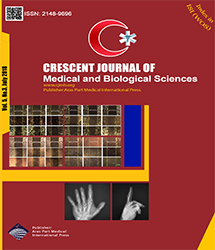
| Original Article | |
| Intralesional Cryotherapy Versus Intralesional Corticosteroid and 5-Fluorouracil in the Treatment of Hypertrophic Scars and Keloids: A Clinical Trial | |
| Hamideh Azimi Alamdari1, Ghazaleh Davarnia1, Hamideh Herizchi Ghadim, Asal Sadri1 | |
| 1Department of Dermatology, Sina Hospital, Tabriz University of Medical Sciences, Tabriz, Iran | |
|
CJMB 2018; 5: 215–221 Viewed : 4119 times Downloaded : 7960 times. Keywords : Keloid, Cryotherapy, Steroid, 5-Fluorouracil, Hypertrophic scar |
|
| Full Text(PDF) | Related Articles | |
| Abstract | |
Objectives: Keloids are raised fbrous scars that extend beyond the boundaries of the original wound and usually reappear after surgical excision. Hypertrophic scars are similar lesions but are limited to wound edges and may regress over time. The aim of the present study was to provide a comparative assessment of intralesional cryotherapy with 2 methods of intralesional injection of triamcinolone and 5-fluorouracil. Materials and Methods: The study was conducted on Iranian Azeri patients with hypertrophic and keloid scars in Sina hospital (Tabriz-Iran) from August 2016 to May 2017. Twenty-one scars were assigned to each group. The frst group received intralesional cryotherapy and the second and third groups were treated with intralesional triamcinolone acetonide (40 mg/mL) 0.2 mL/cm2 and 5-fluorouracil (50 mg/mL) 0.2 mL/cm2, respectively. Dimensions of the scars (including surface area, height and volume) were measured before and after the study. Therapies were repeated every 4 weeks and would be reapplied for 6 sessions depending on the presence of scar tissue. Results: A signifcant decline was found in surface area, height and volume of the scars with cryotherapy after the frst session compared to other 2 methods. The decline in surface area, height and volume after the sixth session was 52.9%, 61.37%, and 78.06% respectively with steroid injection and 32.16%, 58.07%, and 60.67% with 5-FU injection. Results also showed that in terms of surface area, height and volume of the disease, there was a signifcant difference between steroid and 5-FU groups in the sixth session, with the results being more favorable in the former group. Side effects were permanent hypopigmentation, telangiectasia and atrophy in the steroid group; surface wound, hyperpigmentation and increased pain in the 5-FU group; and temporary hypopigmentation in the cryotherapy group. Conclusions: Results showed that intralesional cryotherapy accelerates keloid healing and has fewer side effects than other treatments. |
Cite By, Google Scholar
Google Scholar
PubMed
Online Submission System
 CJMB ENDNOTE ® Style
CJMB ENDNOTE ® Style
 Tutorials
Tutorials
 Publication Charge
Medical and Biological Research Center
About Journal
Publication Charge
Medical and Biological Research Center
About Journal
Aras Part Medical International Press Editor-in-Chief
Arash Khaki
Deputy Editor
Zafer Akan


















